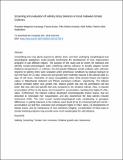| dc.contributor.author | Kamanga, Rowland | |
| dc.contributor.author | Kopa, Fatuma | |
| dc.contributor.author | Sefasi, Abel | |
| dc.contributor.author | Ndakidemi, Patrick | |
| dc.date.accessioned | 2024-01-29T10:31:43Z | |
| dc.date.available | 2024-01-29T10:31:43Z | |
| dc.date.issued | 2023-04-18 | |
| dc.identifier.uri | https://doi.org/10.1007/s40502-023-00718-8 | |
| dc.identifier.uri | https://dspace.nm-aist.ac.tz/handle/20.500.12479/2451 | |
| dc.description | This research article was published in the Plant Physiology Reports, Volume 28, pages 259–271, 2023 | en_US |
| dc.description.abstract | Unravelling how crop plants respond to salinity stress, and their underlying morphological and physiological adaptations could provide benchmarks for development of crop improvement programs in salt affected regions. The purpose of this study was to screen for tolerance and identify morpho-physiological traits underlying salinity tolerance in locally adapted tomato (Solanum lycopersicum L.) cultivars. Six (6) popular Malawian tomato cultivars with unknown response to salinity stress were evaluated under greenhouse conditions by gradual exposure to 200 mM NaCl for 21 days. Shoot and root growth were markedly reduced in all cultivars after 21 days of salt stress. Derivation of stress susceptibility index (SSI) showed lowest and highest values in Mbambande (tolerant) and Phindu (sensitive) cultivars, respectively. The tolerant cultivar exhibited higher crop growth rate, relative growth rate and net assimilation rate but lower leaf area ratio and specific leaf area compared to the sensitive cultivar. Also, it reduced accumulation of Na+ to the leaves, but increased K+ accumulation, resulting into higher K+/Na+ ratios. Furthermore, the tolerant cultivar developed morphologically thicker leaves, that are described to necessitate Na+ sequestration, and also experienced the least salinity induced senescence (SIS). The most crucial morpho-physiological traits contributing to genotypic differences in salinity tolerance in the cultivars were found to be (1) enhanced leaf and root K+ accumulation (2) leaf Na+ exclusion and consequent higher K+/Na+ ratios, (3) development of thicker leaves, and (4) maintenance of root membrane integrity. Consideration of these traits in tomato breeding programs may provide some much-needed gains for salt tolerance. | en_US |
| dc.language.iso | en | en_US |
| dc.publisher | Springer Nature | en_US |
| dc.subject | Tomato; Na+ exclusion; Relative growth rate; Senescence | en_US |
| dc.subject | Tomato | en_US |
| dc.subject | Na+ exclusion | en_US |
| dc.subject | Senescence | en_US |
| dc.title | Screening and evaluation of salinity stress tolerance in local malawian tomato Cultivars | en_US |
| dc.type | Article | en_US |

